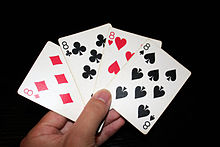|
Craits
Craits (sometimes spelled Crates or Creights) is a shedding card game for two to five players derived from Crazy Eights, which forms the origin of its name. Accounts of the game's origin are unclear, with some sources alleging it was created in the late 1960s in Chicago, Illinois[1] and others in the 1970s in Cambridge, Massachusetts.[2][unreliable source?] Craits is similar to the marketed game Uno, which has its own specialized deck, and many cards share the functions of Uno's specialized cards. RulesBasic principlesA standard deck of 52 playing cards is used; if more than five players wish to play, two decks may be used. To determine the first dealer, cards may be drawn from the deck by each player; whoever drew the lowest card then proceeds with the first deal. A game consists of 15 hands; in the first hand, 8 cards are dealt to each player. In the second hand, 7 cards are dealt, and so on until the eighth hand, when only one card is dealt to each player. Following this, each hand increases the number of cards dealt to each player by one, until the fifteenth hand, in which 8 cards are dealt. In each hand, the deal starts to the left; however, over the course of a hand, this may change. Following the deal, the remaining cards are placed at the centre of the table, and the top card is turned over by the dealer, at which point the player to the left of the dealer begins play for the hand. The playThe first card, and every card thereafter, determines a special function for the next player to follow. The card turned up is treated as being played by the dealer, and follows with whatever function it serves in play before the next player has their turn. In each player's turn, they may play a card of either the same suit or the same rank as the card on the top of the discard pile, or an eight or nine, which are considered wild cards. If a player cannot play any cards, then they must draw one card from the stock and play then proceeds to the next player. An exception to this style of play happens during the count, which is explained in further detail lower. Following each card's play, its action is taken before the next player has their turn. At any time when a player reduces their hand to one card, they must say "one card". Failure to do so (which is often signified by an opponent calling idiot) results in the forfeiting of their next turn and having to draw two cards instead. Each hand ends when any player plays their final card; referred to as going out. However, if this happens during "the count", play continues as usual until it ends normally. Also, the effects of the card are resolved before the hand ends, so if the card is a five, everyone else draws a card before scoring, and so on. Functions of each cardFollowing the play of each card, a special action is taken depending on the rank of the card played. This includes the card turned up by the dealer. The functions of each card are as follows:
The countIf a two is played (including turned up by the dealer), "the count" begins, starting at a value of two. Each player must then play either an ace or a two, increasing the value of the count by either one or two, depending on the card played. If a player can not play an ace or two at this stage, they draw cards from the stock equating to the count value, and normal play resumes with the next player in sequence. This process is also known in some dialects as a crank. ScoringUpon the completion of a hand, the person who gets rid of their last card gets 0 points. The remaining players then add points to their score based on the cards remaining in their hand according to the following point values:
At the end of the game, the player with the lowest cumulative point total is declared the winner. Scoring threesA three left in the hand at the end of play scores 3 points, but it may also be used to cancel out another card in the player's hand. An eight may not, however, have its point value canceled. Example: In a hand containing A, 3, 3, 6, 7, 9, K, the threes may be used to cancel out the point values of the 6 and 9 (as they're the highest scoring cards remaining), and therefore it counts 1 + 3 + 3 + 20 + 10, or 37 points. If a hand is left with only threes at the end of play, each three instead counts -50 points. Shuffle pressureIf a player has to draw a card, but the stock is exhausted, they must then shuffle the cards remaining in the discard pile (except for the top card), and be subject to a shuffle pressure penalty. The first shuffle pressure adds 5 points to the player's score, and every shuffle pressure following doubles the score of the last one; for instance, the second shuffle pressure adds 10 points, the third 20 points, and so on. The penalties for the shuffle pressures are independent for each player, and double throughout the game. If a player has to draw a card, but there are no cards in the draw pile and no cards in the play pile (except for the top card), then they get a shuffle pressure, and the round ends immediately. Variations
Variation that gives functions to face cardsIn a variation of Craits the face cards may be given functions of their own, and the scoring values in this version are the same as in the regular one.
See alsoSources
|
||||||||||||||||||||||||||||||||||||||||||||||||||||||||||||||||||||||||||||||||||
